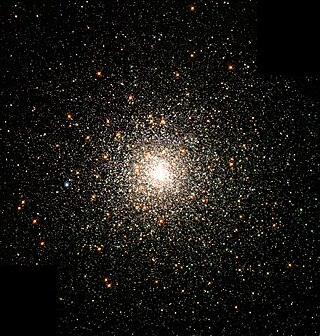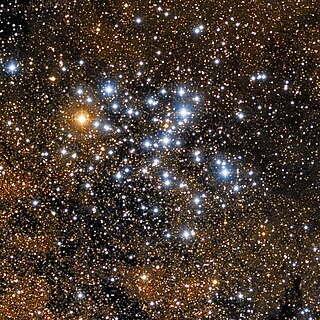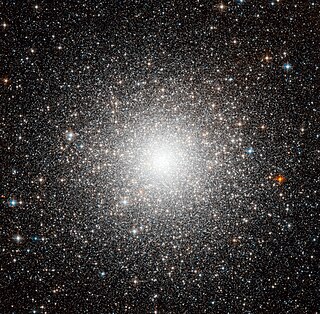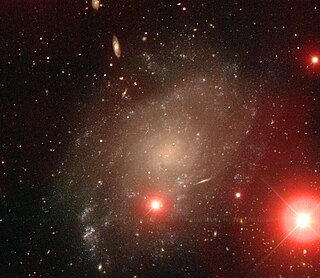Related Research Articles

A galaxy is a system of stars, stellar remnants, interstellar gas, dust, and dark matter bound together by gravity. The word is derived from the Greek galaxias (γαλαξίας), literally 'milky', a reference to the Milky Way galaxy that contains the Solar System. Galaxies, averaging an estimated 100 million stars, range in size from dwarfs with less than a thousand stars, to the largest galaxies known – supergiants with one hundred trillion stars, each orbiting its galaxy's center of mass. Most of the mass in a typical galaxy is in the form of dark matter, with only a few percent of that mass visible in the form of stars and nebulae. Supermassive black holes are a common feature at the centres of galaxies.

Sandra Moore Faber is an American astrophysicist known for her research on the evolution of galaxies. She is the University Professor of Astronomy and Astrophysics at the University of California, Santa Cruz, and works at the Lick Observatory. She has made discoveries linking the brightness of galaxies to the speed of stars within them and was the co-discoverer of the Faber–Jackson relation. Faber was also instrumental in designing the Keck telescopes in Hawaii.
The Sloan Digital Sky Survey or SDSS is a major multi-spectral imaging and spectroscopic redshift survey using a dedicated 2.5-m wide-angle optical telescope at Apache Point Observatory in New Mexico, United States. The project began in 2000 and was named after the Alfred P. Sloan Foundation, which contributed significant funding.

Messier 80 is a globular cluster in the constellation Scorpius. It was discovered by Charles Messier in 1781, being one of his first discoveries.

The Butterfly Cluster is an open cluster of stars in the southern constellation of Scorpius. Its name derives from the vague resemblance of its shape to a butterfly. The Trumpler classification of II 3 r encodes it is rich in stars, ranks II out of IV for disparateness and greatly mixes bright with faint components. It is 3.5° to the northwest of Messier 7, both north of the tail of Scorpius.

Messier 54 is a globular cluster in the constellation Sagittarius. It was discovered by Charles Messier in 1778 and then included in his catalog of comet-like objects.

Messier 56 is a globular cluster in the constellation Lyra. It was discovered by Charles Messier in 1779. It is angularly found about midway between Albireo and Sulafat. In a good night sky it is tricky to find with large (50–80 mm) binoculars, appearing as a slightly fuzzy star. The cluster can be resolved using a telescope with an aperture of 8 in (20 cm) or larger.

Willman 1 is an ultra low-luminosity dwarf galaxy or a star cluster. Willman 1 was discovered in 2004. It is named after Beth Willman of Haverford College, the lead author of a study based on the Sloan Digital Sky Survey data. The object is a satellite of the Milky Way, at ~120,000 light-years away. Willman 1 has an elliptical shape with the half-light radius of about 25 pc. Its heliocentric velocity is approximately −13 km/s.

NGC 5170 is a large, nearby, edge-on spiral galaxy in the equatorial constellation of Virgo. It was discovered on February 7, 1785 by William Herschel. This galaxy is located at a distance of 83.5 million light years and is receding at a heliocentric radial velocity of 1,502 km/s. It is a member of the Virgo II Groups, a series of galaxies and galaxy clusters strung out from the southern edge of the Virgo Supercluster.

Heidi Jo Newberg is an American astrophysicist known for her work in understanding the structure of our Milky Way galaxy. Among her team's findings are that the Milky Way is cannibalizing stars from smaller galaxies and that the Milky Way is larger and has more ripples than was previously understood. She is a founding participant in the Sloan Digital Sky Survey (SDSS) and the Sloan Extension for Galactic Understanding and Exploration (SEGUE), and is a leader of the astrophysical MilkyWay@home volunteer computing project team. She is a professor in the Department of Physics, Applied Physics, and Astronomy at Rensselaer Polytechnic Institute (RPI) in Troy, New York, US, and a Fellow of the American Physical Society.
Segue 1 is a dwarf spheroidal galaxy or globular cluster situated in the Leo constellation and discovered in 2006 by Sloan Digital Sky Survey. It is located at a distance of about 23 kpc from the Sun and moves away from the Sun with the velocity of about 206 km/s. Segue 1 has a noticeably elongated shape with the half-light radius of about 30 pc. This elongation may be caused by the tidal forces acting from the Milky Way galaxy if Segue 1 is being tidally disrupted now.

NGC 45 is a low surface brightness spiral galaxy in the equatorial constellation of Cetus. It was discovered on 11 November 1835 by the English astronomer John Herschel. The galaxy is located at a distance of 22 million light years and is receding with a heliocentric radial velocity of 466 km/s. It is located in the vicinity of the Sculptor Group, but is most likely a background galaxy.
Rosemary F. G. Wyse is a Scottish astrophysicist, Fellow of the Royal Astronomical Society (FRAS), and Alumni Centennial Professor of Physics and Astronomy at Johns Hopkins University.

NGC 4372 is a globular cluster in the southern constellation of Musca. It is southwest of γ Muscae and west of the southern end of the Dark Doodad Nebula, a 3° thin streak of black across a southern section of the great plane of the Milky Way.
The metallicity distribution function is an important concept in stellar and galactic evolution. It is a curve of what proportion of stars have a particular metallicity of a population of stars such as in a cluster or galaxy.
The University of California High-Performance AstroComputing Center (UC-HiPACC) based at the University of California at Santa Cruz (UCSC) is a consortium of nine University of California campuses and three Department of Energy laboratories. The consortium's goal is to support and facilitate original research and education in computational astrophysics and to engage in public outreach and education.
YBP 1194 is a G-type main-sequence star, class G5V, in the open cluster M67 in the constellation Cancer. It is the best solar twin found to date, having the near exact temperature and mass as the Sun. YBP 1194 has a higher metallicity than the Sun and is 0.5 billion years younger at an age of 4.2 billion years old, but due to the distance, the error bar is high at ±1.6 billion years. On December 19, 2013, it was announced to have an extrasolar planet with a period of 6.9 days and a high eccentricity of 0.24 with a mass of 0.34 MJ. It is about 2,772 light-years from the Sun. It is packed in a small cluster, Messier 67, with a radius of 10 ly, with over 500 other stars. For comparison, the Sun has 17 stars at a distance of 10 ly and about 134 stars at a distance of 20 ly.
Risa H. Wechsler is an American cosmological physicist, Professor of Physics at Stanford University, and Professor of Particle Physics and Astrophysics at SLAC National Accelerator Laboratory. She is the director of the Kavli Institute for Particle Astrophysics and Cosmology.
Claudia Maraston is a Professor of Astrophysics at the University of Portsmouth. She designs models for the calculation of spectro-photometric evolution of stellar populations. She is the winner of the 2018 Royal Astronomical Society Eddington Medal.
References
- ↑ "Mapping the Sky". UC Santa Cruz Newscenter. 2012-10-12. Retrieved 2023-03-10.
- ↑ "Faculty Directory". UC Santa Cruz Astronomy & Astrophysics. Retrieved 2023-03-10.
- 1 2 Koppes, Steve (15 November 2007). "Sloan Digital Sky Survey: Universe of data changes face of astronomy". Chronicle. 27 (5). Chicago, Illinois: The University of Chicago . Retrieved October 31, 2015.
- 1 2 3 4 "UCO Lick Observatory". ucolick.org.
- 1 2 Janek, Vanessa (6 January 2015). "Hearing the Early Universe's Scream: Sloan Survey Announces New Findings". Universe Today . Retrieved 31 October 2015.
- 1 2 3 Moskowitz, Clara (10 January 2012). "Milky Way Galaxy's Past Revealed Through New Star Census". Space. Retrieved 31 October 2015.
- 1 2 "UCSC Faculty Pages".
- ↑ "Sloan Digital Sky Survey: Largest Color Image of the Sky Ever Made". www.spaceref.com. Retrieved 2022-04-10.
- ↑ Rockosi, Constance M. (2001). "Detection and analysis of the tidal tails around the globular cluster Palomar 5 in the SDSS commissioning data /". catalog.lib.uchicago.edu. OCLC 49951058 . Retrieved 2022-04-10.
- ↑ "New Sky Atlas Opens to First Pages". www.science.org. 8 June 1998. Retrieved 2022-04-10.
- ↑ "2017 and Prior Fellows". STScI.edu. Retrieved 2022-04-10.
- 1 2 Rockosi, Constance (2017). "Constance M. Rockosi" (PDF). Retrieved 10 April 2022.
- 1 2 3 "UCO Technical Laboratories". University of California Observatories. Retrieved 2022-04-10.
- ↑ "Dark Energy Instrument's Lenses See the Night Sky for the First Time". Tech Explorist. 2019-04-04. Retrieved 2022-04-10.
- ↑ "UCO Advisory Committee". University of California Observatories. Retrieved 2022-04-10.
- ↑ Stephens, Tim. "Claire Max to retire as director of UC Observatories". UC Santa Cruz News. Retrieved 2022-04-10.
- ↑ Stephens, Tim. "Astrophysicist Bruce Macintosh appointed director of UC Observatories". UC Santa Cruz Newscenter. Retrieved 2023-03-10.
- ↑ Yanny, Brian; Rockosi, Constance; Newberg, Heidi Jo; Knapp, Gillian R.; Adelman-McCarthy, Jennifer K.; Alcorn, Bonnie; Allam, Sahar; Prieto, Carlos Allende; An, Deokkeun; Anderson, Kurt S. J.; Anderson, Scott (2009-04-07). "SEGUE: A SPECTROSCOPIC SURVEY OF 240,000 STARS WITHg= 14-20". The Astronomical Journal. 137 (5): 4377–4399. arXiv: 0902.1781 . Bibcode:2009AJ....137.4377Y. doi: 10.1088/0004-6256/137/5/4377 . ISSN 0004-6256. S2CID 39279981.
- ↑ "Deep in Space". City on a Hill Press. 2010-04-15. Retrieved 2022-04-10.
- ↑ "NSF Award Search: Award # 1616540 - Learning how the Milky Way was Assembled through Measurements of Positions, Velocities and Elements in Stars in the Halo". www.nsf.gov. Retrieved 2022-04-10.
- ↑ Stephens, Tim. "DESI opens its 5,000 eyes to capture the colors of the cosmos". UC Santa Cruz News. Retrieved 2022-04-10.
- ↑ "Chemical Abundance Trends in the Milky Way Disk: Implications on the Origin of the Galactic Thick Disk". eScholarship. UC Santa Cruz, Santa Cruz, California: UC Santa Cruz. June 2012. Retrieved October 31, 2015.
- ↑ Lai, David K.; Rockosi, Constance M.; Bolte, Michael; Johnson, Jennifer A.; Beers, Timothy C.; Lee, Young Sun; Prieto, Carlos Allende; Yanny, Brian (20 May 2009). "A Unique Star in the Outer Halo of the Milky Way". The Astrophysical Journal. doi:10.15781/T23T9D87M. ISSN 0004-637X.
- ↑ Lee, Young Sun; Beers, Timothy C.; Masseron, Thomas; Plez, Bertrand; Rockosi, Constance M.; Sobeck, Jennifer; Yanny, Brian; Lucatello, Sara; Sivarani, Thirupathi; Placco, Vinicius M.; Carollo, Daniela (2013-10-17). "Carbon-Enhanced Metal-Poor Stars in SDSS/Segue. I. Carbon Abundance Estimation and Frequency of Cemp Stars". The Astronomical Journal. 146 (5): 132. arXiv: 1310.3276 . Bibcode:2013AJ....146..132L. doi: 10.1088/0004-6256/146/5/132 . ISSN 0004-6256. S2CID 118468060.
- ↑ Hillman, Dan (2010-12-07), The Joy of Stats (Documentary), Wingspan Productions, retrieved 2022-04-10